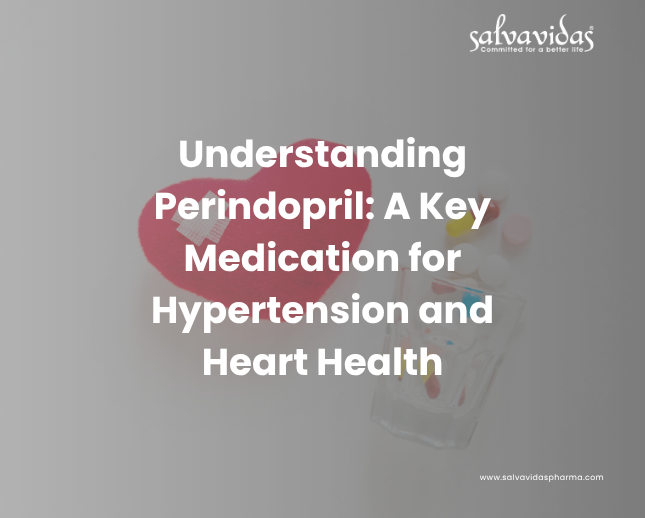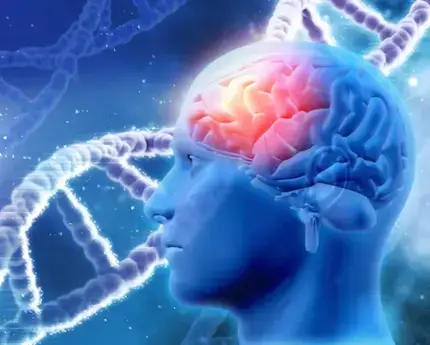
In today’s fast-paced world, the rise in hypertension and heart-related conditions has become a global concern. With millions affected by high blood pressure and cardiovascular diseases, finding effective and reliable medications is essential. One of the most widely prescribed treatments is Perindopril, an ACE (Angiotensin-Converting Enzyme) inhibitor known for its important role in managing blood pressure and supporting overall heart health. In this blog, we’ll explore what Perindopril is, how it works, its common uses, and why it continues to be a preferred choice among healthcare professionals. What is Perindopril? Perindopril is a prescription medication that belongs to a class of drugs known as ACE inhibitors (Angiotensin-Converting Enzyme inhibitors). These medications work by relaxing blood vessels, making it easier for the heart to pump blood throughout the body. This action helps lower blood pressure and reduces the risk of heart attacks, strokes, and kidney complications. One of the most commonly used forms is Perindopril Erbumine, which is the erbumine salt of perindopril. This formulation is widely prescribed due to its excellent absorption profile and good tolerability in patients. How Perindopril Works in the Body Perindopril works by blocking the enzyme that converts angiotensin I into angiotensin II- a substance that causes blood vessels to narrow. By reducing the levels of angiotensin II in the body, Perindopril allows blood vessels to relax and widen, effectively lowering blood pressure. This reduction in pressure not only eases the heart’s workload but it also improves the delivery of oxygen and nutrients to vital organs. As a result, Perindopril is also used in the long-term management of heart failure and to reduce the risk of stroke in individuals with high blood pressure Common Dosages: Perindopril 4mg and Perindopril 8 mg Perindopril is available in various strengths, with Perindopril 4mg and Perindopril 8 mg being the most commonly prescribed doses. Doctors typically adjust these doses based on a patient’s age, medical condition, and how well the medicine is tolerated. Perindopril 4mg: Commonly used as an initial dose for patients with mild hypertension or those beginning treatment. Perindopril 8 mg: A higher maintenance dose prescribed for patients requiring stronger blood pressure control or those with established heart conditions. These dosages should only be taken as directed by a physician to avoid adverse effects or complications, especially in an era where therapeutic treatments are moving toward greater precision and personalization. Perindopril Uses: What Conditions Does It Treat? Perindopril is effective in managing a range of cardiovascular and kidney-related conditions. Below are its primary uses: 1. Hypertension (High Blood Pressure) Perindopril is primarily used to treat high blood pressure. By lowering blood pressure, it helps reduce the risk of strokes, heart attacks, and kidney problems. 2. Heart Failure Perindopril is used in the management of congestive heart failure. It reduces strain on the heart, helping to relieve symptoms such as shortness of breath and fatigue. 3. Stable Coronary Artery Disease For patients with stable coronary artery disease, Perindopril helps lower the risk of heart-related events by improving blood flow and reducing workload on the heart. 4. Post-Stroke Risk Reduction Perindopril may also be prescribed after a stroke, or in patients at high risk of stroke- especially when used in combination with other medications to reduce the likelihood of recurrence. Perindopril Erbumine: A Preferred Formulation As mentioned earlier, Perindopril Erbumine is a widely used salt form of the Perindopril. It offers consistent and effective blood pressure control and is known for its good bioavailability. This formulation is often preferred by healthcare providers when managing patients with chronic cardiovascular conditions due to its reliability and tolerability. Potential Side Effects and Precautions Like all medications, Perindopril may cause side effects. Common side effects include: Dizziness or lightheadedness Dry cough Headache Fatigue More serious but uncommon side effects include kidney problems, high potassium levels, or angioedema- a rare allergic reaction causing swelling of the face or mouth. Before starting Perindopril, patients should inform their doctor or healthcare provider about any existing medical conditions or other medications they are taking to avoid potential interactions or complications. Perindopril though widely used as an active pharmaceutical ingredient—is not recommended during pregnancy, and individuals with kidney disorders should use it with caution under close medical supervision. Why Perindopril is Trusted Worldwide Numerous clinical trials have demonstrated the effectiveness of perindopril. It is trusted globally for its ability to reduce long-term cardiovascular risks and for its compatibility with other blood pressure medications. Perindopril continues to play a key role in the treatment of hypertension and heart-related conditions both in its generic and brand-name forms. Conclusion Perindopril remains one of the most effective and widely prescribed ACE inhibitors for managing high blood pressure and supporting heart health. Whether used in its standard form or as Perindopril Erbumine, the medication delivers proven results with a favorable safety profile. With flexible dosage options like Perindopril 4mg and Perindopril 8 mg, healthcare providers can personalize treatment plans to meet individual patient needs. Understanding how Perindopril works, what it treats, and why it’s trusted helps patients take a more informed, proactive role in their heart health. If you’re considering Perindopril or are currently taking it, always consult your healthcare provider for personalized advice and regular follow-up. Have questions or need support? Contact us today to learn more.

🌍 Salvavidas Pharmaceutical Pvt. Ltd. Celebrating World Environment Day, A Responsible Pharmaceutical Manufacturer & Exporter from India. Introduction to World Environment Day Every year on June 5th, the world unites to celebrate something greater than ourselves—our planet. World Environment Day is more than a calendar event. It’s a global movement calling for action to protect the Earth we share. At Salvavidas Pharmaceutical Pvt. Ltd., a leading Pharmaceutical Manufacturer & Exporter from India, we’re committed to sustainable practices that preserve health—not just of people, but the planet too. 🌱 The Origins of World Environment Day 📅 When and Why It Started World Environment Day began in 1972, sparked by the UN Conference on the Human Environment in Stockholm. It marked a turning point—recognizing that our development must respect environmental limits. 🌍 UNEP’s Role Since its inception, the United Nations Environment Programme (UNEP) has coordinated efforts to raise awareness and mobilize environmental action globally. 🔄 Evolving into a Global Movement Over the decades, this day has inspired actions across 150+ countries, influencing everything from climate policies to grassroots activism. 💡 Why It Matters to Us as a Pharmaceutical Exporter from India 🧠 Global Awareness World Environment Day reminds us that industrial growth and environmental care must go hand in hand. As a responsible Pharmaceutical Exporter from India, we aim to lead by example. ♻️ Driving Sustainable Practices in Pharma At Salvavidas Pharmaceutical Pvt. Ltd., we implement green manufacturing initiatives—such as waste reduction, eco-conscious packaging, and clean-energy transitions—aligning our operations with global sustainability goals. 🏛️ Industry Responsibility The pharma industry has a critical role to play. Our mission is to promote health without harming the environment, staying true to our values as a Pharmaceutical Manufacturer from India serving the world. 🎨 2025 Theme: “Land Restoration, Desertification, and Drought Resilience” This year’s focus emphasizes the urgent need to reverse land degradation and enhance drought resilience—issues that connect directly to agriculture, medicine, and human survival. Themes give direction and focus, helping organizations channel their efforts into one unified message—amplifying impact. ⚠️ Environmental Challenges That Affect Pharma Too Climate Change – Impacts sourcing of raw materials and health outcomes Water Scarcity – Affects manufacturing & sanitation Pollution – Including pharma waste, demands stricter waste management Loss of Biodiversity – Limits discovery of natural-origin medicines Deforestation – Disrupts the balance of ecosystems that support life As a Pharmaceutical Manufacturer from India, we understand how these issues directly impact global health and pharmaceutical supply chains. Themes give direction and focus, helping organizations channel their efforts into one unified message—amplifying impact. 🚀 Our Actions at Salvavidas Pharmaceutical Pvt. Ltd. ♻️ Minimizing plastic in packaging 🚱 Optimizing water use in production 🧪 Developing green chemistry formulations 🎉 Global and Local Impact 🌐 Worldwide Celebrations From eco-exhibitions in Europe to clean-up campaigns in Africa, World Environment Day is a platform for global solidarity. Indian Pharma’s Role India is not only a pharmaceutical powerhouse but also a rising leader in green innovation. Companies like Salvavidas Pharmaceutical Pvt. Ltd. are proud to contribute to both healthcare and environmental stewardship. 🌿 How You Can Contribute 🏡 At Home Recycle responsibly Switch to energy-efficient appliances Reduce single-use plastics 💼 At Work Promote paperless operations Support local sustainability initiatives Suggest eco-friendly alternatives in supply chains 🏘️ In Pharma Use green chemistry where possible Follow stringent waste disposal protocols Educate teams about eco-compliance 🔮Beyond One Day: Our Long-Term Vision World Environment Day is a reminder, but our commitment is year-round. At Salvavidas Pharmaceutical Pvt. Ltd., we view sustainability as a core pillar—not an afterthought. By adopting UN Sustainable Development Goals (SDGs) and aligning with global environmental standards, we aim to be a Pharmaceutical Exporter from India known not just for product quality, but planet-first thinking. 🏁 Final Thoughts World Environment Day challenges us to reflect—and more importantly, to act. Every action we take, every decision we make as a company or as individuals, shapes the world we leave behind. As a responsible Pharmaceutical Manufacturer & Exporter from India, Salvavidas Pharmaceutical Pvt. Ltd. is proud to stand at the intersection of healthcare and environmental care. Together, we can make sustainability more than just a trend—it can be a legacy ❓ FAQs 1. Why should pharmaceutical companies care about World Environment Day? A. Because the health of people and the planet are interconnected. Environmental degradation leads to new health challenges. 2. What makes Salvavidas different from other exporters? A.We combine high-quality manufacturing standards with eco-conscious operations, setting us apart as a Pharmaceutical Exporter from India committed to sustainable growth. 3. How is sustainability integrated into pharma? A. Through energy-efficient facilities, green R&D, and ethical sourcing. 4. Can exporting medicines be eco-friendly? A. Absolutely. With the right packaging, logistics, and waste-reduction strategies, exporters can reduce their carbon footprint significantly. 5. Is World Environment Day relevant to manufacturers? A. Very much. Manufacturers influence global emissions, water usage, and waste. Responsible practices have both economic and ecological benefits.

Introduction Neurology is a captivating branch of medical science that delves into the complexities of the human brain and nervous system. With its focus on the study, diagnosis, and treatment of neurological disorders, neurology plays a pivotal role in unraveling the mysteries of our most vital organ—the brain. In this comprehensive article, we will delve deep into the fascinating realm of neurology, exploring its significance, the intricacies of the nervous system, common neurological disorders, and the advancements being made in this field. Neurology: Decoding the Marvels of the Brain The field of neurology encompasses the study of the nervous system, which is responsible for transmitting signals throughout the body. This intricate network of nerves, cells, and specialized structures enables us to think, feel, move, and experience the world around us. Understanding the complexities of the nervous system is crucial for diagnosing and treating a wide range of neurological conditions. The Human Brain: An Astonishing Organ The human brain, often referred to as the command center of the body, is an extraordinary organ with a myriad of functions. From controlling our bodily functions to enabling complex cognitive processes, the brain is truly remarkable. Let’s delve into some of the key aspects of the human brain: 1. Structure and Functions of the Brain The brain is divided into several distinct regions, each responsible for different functions. These regions include: Cerebrum: The largest part of the brain, responsible for conscious thoughts, memory, and voluntary movements. Cerebellum: Located at the back of the brain, it coordinates movement, balance, and posture. Brainstem: Connecting the brain to the spinal cord, it regulates essential functions like breathing, heart rate, and blood pressure. 2. Neurotransmitters: Messengers of the Brain Neurotransmitters are chemicals that facilitate communication between nerve cells in the brain. They play a crucial role in various brain functions and emotions. Some well-known neurotransmitters include: Serotonin: Regulates mood, appetite, and sleep. Dopamine: Associated with pleasure, motivation, and reward. Acetylcholine: Involved in memory and muscle control. 3. Plasticity and Neurogenesis Contrary to the long-held belief that the brain doesn’t change after a certain age, research has shown that the brain is remarkably adaptable. Plasticity refers to the brain’s ability to reorganize itself and form new connections. Neurogenesis, on the other hand, refers to the generation of new neurons in certain regions of the brain, even in adulthood. 4. Common Brain Disorders The brain is susceptible to various disorders, which can have a significant impact on an individual’s quality of life. Some common neurological disorders include: Alzheimer’s disease: A progressive brain disorder that impairs memory and cognitive function. Parkinson’s disease: A degenerative disorder affecting movement and coordination. Epilepsy: A condition characterized by recurrent seizures caused by abnormal brain activity. The Role of Neurologists: Experts in Brain Health Neurologists are medical professionals specializing in the diagnosis and treatment of neurological disorders. With their extensive knowledge of the nervous system and its intricacies, neurologists play a vital role in ensuring brain health. They employ a range of techniques, including advanced imaging, neurological examinations, and specialized tests, to diagnose and manage various conditions. FAQs (Frequently Asked Questions) Q: What are some common symptoms of neurological disorders? A. Common symptoms of neurological disorders include headaches, dizziness, seizures, numbness or tingling, muscle weakness, and memory problems. Q: How are neurological disorders diagnosed? A. Neurological disorders are diagnosed through a combination of medical history evaluations, neurological examinations, imaging tests (such as MRI or CT scans), and specialized diagnostic procedures. Q: Can neurological disorders be prevented? A. While not all neurological disorders can be prevented, adopting a healthy lifestyle, managing stress, protecting the head from injuries, and getting regular exercise can contribute to brain health. Q: What are some treatment options for neurological disorders? A. Treatment options for neurological disorders vary depending on the specific condition but may include medications, physical therapy, occupational therapy, and in some cases, surgery. Q: Is there ongoing research in the field of neurology? A. Absolutely! Neurology is a rapidly advancing field, with ongoing research focusing on understanding the brain’s intricacies, developing innovative treatments, and improving patient care. Q: How can I maintain a healthy brain? A. Maintaining a healthy brain involves adopting a balanced diet, engaging in regular physical and mental exercise, getting adequate sleep, managing stress, and avoiding harmful substances. Conclusion Neurology, the study of the nervous system and its disorders, plays a vital role in unraveling the mysteries of the human brain. With its broad scope, neurology helps us understand brain function, diagnose and treat neurological conditions, and pave the way for groundbreaking medical advancements. By exploring the intricacies of the nervous system, neurologists continue to make strides in enhancing brain health and improving the lives of individuals affected by neurological disorders. Happy family store

0